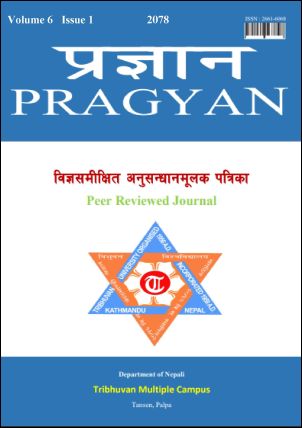हामी कवितामा अलङ्कार {Rhetorics in the Poem ‘Haami’}
DOI:
https://doi.org/10.3126/pragyan.v6i1.54704Keywords:
प्रतीकात्मक, गूढार्थ, व्यङ्ग्यात्मक, आस्वाद्य, अलङ्कारAbstract
प्रस्तुत अध्ययनमा कवि भूपि शेरचनको ‘हामी’ कवितालाई अलङ्कारका कोणबाट विश्लेषण गरिएको छ । काव्यसाहित्यको आस्वाद्य तत्वका रूपमा रहेको अलङ्कार पूर्वीय काव्यशास्त्रको पुरानो स्थापित मान्यता हो । कवि भूपि शेरचनको २०१७ सालमा लेखिएको र रूपरेखा पत्रिकामा प्रकाशित ‘हामी’ कविता पछि उनको ‘घुम्नेमेचमाथि अन्धो मान्छे’ (२०२६) कविता सङ्ग्रहमा सङ्कलित व्यङ्ग्यपूर्ण कविता हो । विभिन्न शैक्षिक तहका पाठ्यक्रममा समाविष्ट ‘हामी’ कवितामा केकस्ता अर्थालङ्कारहरूको प्रयोग किन र कसरी गरिएको छ भन्ने कुराको विश्लेषण यस लेखमा गरिएको छ । अलङ्कार प्रयोगकै कारण कवि भूपि शेरचनको समाजप्रतिको दृष्टिकोण के कसरी प्रकट भएको छ भन्ने कुराको निक्र्योल यस लेखमा गरिएको छ । प्रस्तुत लेख तयारीका क्रममा कवि भूपि शेरचनको ‘हामी’ कवितालाई प्राथमिक सामग्रीका रूपमा उपयोग गरिएको छ भने द्वितीयक सामग्रीका रूपमा कवि भूपि शेरचनको ‘हामी’ कविताका सन्दर्भमा प्रकाश पारी लेखिएका पुस्तक, पत्रपत्रिका, शोधप्रबन्ध तथा अलङ्कार सिद्धान्तसँग सम्बन्धित संस्कृत ग्रन्थहरूको उपयोग गरिएको छ । कविताको अलङ्कारपरक विश्लेषणका क्रममा वर्णनात्मक, व्याख्यात्मक र विश्लेषणात्मक विधिको प्रयोग गरी अलङ्कार प्रयोगकै कारण ‘हामी’ कविता केकस्तो कलात्मक, काव्यिक, गम्भीर र आस्वादनयुक्त बन्नपुगेको छ भन्ने कुरा अर्थापनविधिमार्फत स्पष्ट पारिएको छ ।
{In the present study, poet Bhupi Sherchan's poem 'Haami' has been analyzed from the angle of rhetoric. Rhetoric as an enjoyable element of poetry is an old established belief of Eastern poetry. Poet Bhupi Sherchan's poem 'Hami', written in 2017 and published in Ruprekha magazine, is a satirical poem compiled in his collection of poems Ghumne Mechmathi Andhomanchhe (2026). This article analyzes why and how allusions are used in the poem which is included in the curriculum of different educational levels. In this article, it has been revealed that the attitude of the poet Bhupi Sherchan towards the society has been revealed due to the use of rhetoric. Poet Bhupi Sherchan's poem 'Haami' has been used as primary material in the preparation of the present article while books, journals, dissertations and Sanskrit texts related to rhetorical theory have been used in the context of Bhupi Sherchan's poem 'Haami' as secondary material. In the course of rhetorical analysis of poetry, it has been made clear through the interpretation method how the poem 'Hami' has become artistic, poetic, serious and tasteful due to the use of rhetoric using descriptive, explanatory and analytical methods.}




